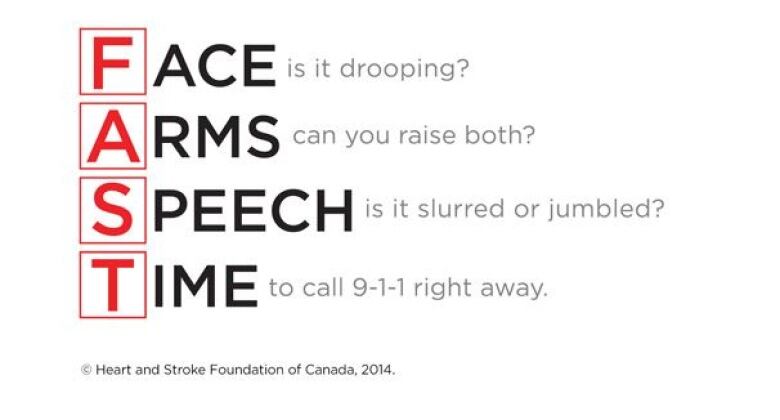More women die after stroke than men, Heart & Stroke says
'Women don't realize that they're susceptible,' says foundation's Patrice Lindsay

A little over a year ago, Julie Tomaino had a stroke that affected both sides of her brain, leaving her "locked in" consciousbut unable to speak or move for about 10 days.
The former professional dancer who works in theatre directing and choreographing plays was just 38 years old.
"I couldn't respond to anything and I could just move my eyeballs," the Toronto resident recalled Monday from Vancouver Island, where she is in rehearsals for a production of the musical Grease.
I couldn't respond to anything and I could just move my eyeballs.- JulieTomaino
Tomaino had been having daily headaches fortwo weeks and knew there was something seriously wrong. But after examiningher earlier that day at the hospital, doctors had sent her home with a diagnosis of migraine and anxiety.
That evening, she started vomiting uncontrollably and began experiencing double vision. Her husband called an ambulance and she remembers being put into the vehicle.
"And thenit's all black for 12 hours."
Tomaino had suffered a major stroke, the result of the inner carotid arteries on both sides of her neck dissecting, or tearing, which caused blood to pool in the vessels and send clots to her brain.
While stroke at her age isn't all that common the average female victim is close to four decades older her story illustrates a message theHeart and Stroke Foundationis trying to bring to public awareness with a report released Tuesday showing how stroke can affect women differently than men.
"A lot of women don't realize that they're susceptible;they tend to focus on cancer, breast cancer and other diseases," said spokespersonPatrice Lindsay.
Worse prognosis for women
As the report outlines, one-third more women die from having a stroke than do their male counterparts, and women are 60 per cent less likely to regain their independence afterward, with a worse prognosis for recovery than men. Less than half of stroke patients who participate in rehabilitation programs are female.
Women are also less likely than men to return home after being treated: twice as many women go into long-term care following a stroke.
Elderly women have the highest rate of stroke, with the risk increasing gradually after menopause; pregnant women have a slightly higher risk of suffering a stroke than non-pregnant women of child-bearing age, in particular if they experience elevated blood pressure or gestational diabetes.

In fact, high blood pressure is a prime risk factor for stroke in both adult women and men, as are diabetes and smoking.
"Women are more likely to have high blood pressure and women are more likely to have an irregular heartbeata condition known as atrial fibrillation," said Lindsay. Atrial fibrillation can lead to blood pooling inside a chamber of the heart, allowing clots to form and travel to the brain, where they block blood vessels and cause a stroke.
"And both of those strongly contribute to stroke and strongly contribute to strokes that have bad outcomes," she said.
'Gaps in knowledge'
Women who have had a strokelater in lifemay be widowed or living alone and often don't have family support at home to help them recover, whereas male stroke survivors often havea spouse to help them regain physical function to a greater degree.
"I think one of the things this report highlights is that there are some gaps in knowledge when it comes to women and stroke, so we don't fully understand why women's prognosis after stroke is worse or what are the things that really drive that observed difference," said Dr. MoiraKapral, a specialist at Toronto's University Health Networkwhose research focuses on stroke health services.
"Until we understand that, we can't develop effective treatment," saidKapral, adding that stroke research is increasingly being targeted towardwomen.
- New stroke guidelines mean more patients could get life-changing treatment
- Bridging the gender-gap in the science of strokes
- 'Accidental scientist' among winners of $100K Killam Prize
Tomaino, who spent almost four weeks in hospital, then six weeks in the Toronto Rehab Hospital, followed by a total of 11 weeks doing rehabilitation as an out-patient, said she is physically recovered except for numbness in one finger and in an area on one side of her chest.
The speech centre of her brain was severely affected, and that presented a major challenge, she said. "I have worked hard at getting it back, but there's just sometimes when I'm tired that I have trouble wrapping my mouth around the words."
Her message to other women, based on her experience of a delayed diagnosis: "Trust yourself. When you think you have a serious problem, advocate for yourself."
That means starting with an awareness of the signs of stroke, stressed Lindsay, which are summed up by the acronym FAST:
- Facial drooping.
- Arm weakness.
- Speech difficulties.
- Time to call emergency services.
Stroke is a medical emergency. It's critical to get treatment such as clot-busting drugs to limit damage to brain cells andimprove the chances of recovery, she said.












_(720p).jpg)


 OFFICIAL HD MUSIC VIDEO.jpg)
.jpg)



























































































